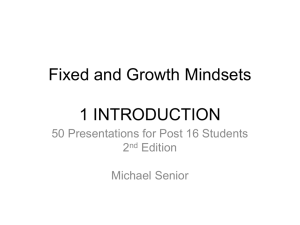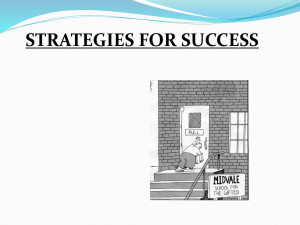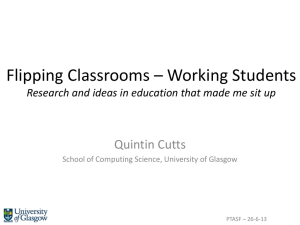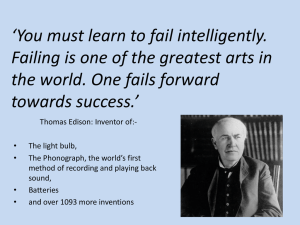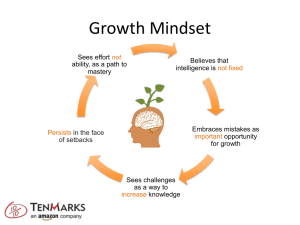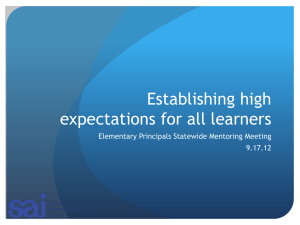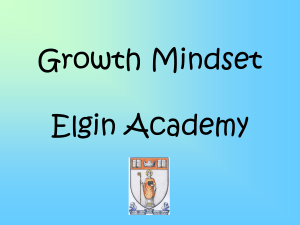Mindset MiniModule
advertisement
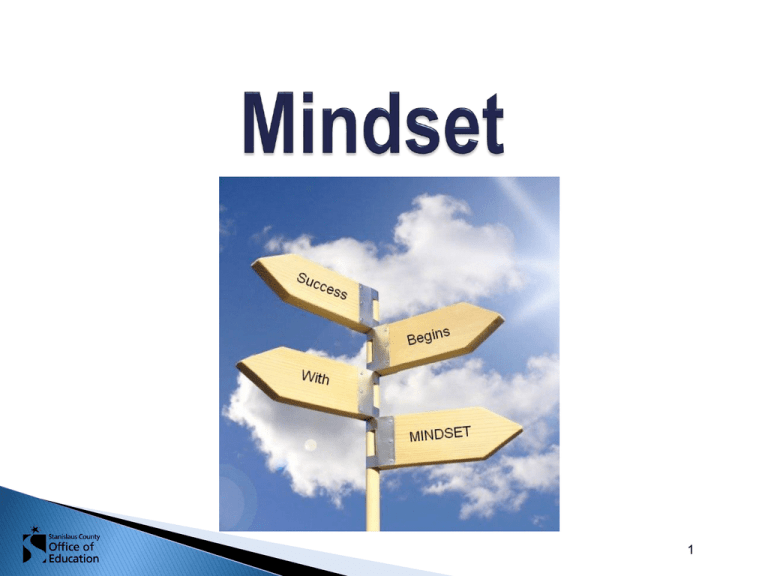
1 Beliefs people hold about their most basic qualities and abilities 2 Privately circle your level of agreement with the 8 statements. 3 1. For questions with ODD numbers (1,3,5,7), write the number of your answer in the right column. 2. For questions with EVEN numbers (2,4,6,8), use the table below to fill in the gray boxes in the right column. 3. Now, add up all your profile numbers and write the total in the last box. Source: Brainology Curriculum Guide 4 Source: Brainology Curriculum Guide 5 Mindsets are beliefs—beliefs about yourself and your most basic qualities. People with a fixed mindset tend to believe that traits are fixed qualities. They have a certain amount of intelligence or talent, for example, and nothing can change that. People with a growth mindset believe these qualities can be developed through dedication and effort. 6 6 “I’m not good at math!” “I am not a good writer.” “My students can’t do this!” 7 Research has shown that students who hold a Growth Mindset perform better than those with a Fixed Mindset, especially under conditions of challenge. (Blackwell, Trzesniewski, & Dweck, 2007) However, these mindsets themselves are learned, and they can be changed. Adult feedback can influence students’ mindset and performance in powerful ways. (Mueller & Dweck, 1998) When students are taught that the brain develops and gets smarter with effort and learning, they become motivated in school and perform better. (Blackwell, Trzesniewski, & Dweck, 2007; Good, Aronson, & Inzlicht, 2003) 8 Fixed Mindset Intelligence is static Growth Mindset Intelligence can be developed 9 Fixed Mindset Intelligence is static Growth Mindset Intelligence can be developed Obstacles 10 Fixed Mindset Intelligence is static Growth Mindset Intelligence can be developed Effort 11 Fixed Mindset Intelligence is static Growth Mindset Intelligence can be developed Criticism 12 Fixed Mindset Intelligence is static Growth Mindset Intelligence can be developed Success of Others 13 Those with a Fixed Mindset may plateau early and achieve less than their full potential. Those with a Growth Mindset reach ever-higher levels of achievement. 14 Use the graphic organizer to compare and contrast growth and fixed mindsets, using your own words Fixed Mindset Growth Mindset 15 Mindsets in Action 16 http://www.mindsetworks.com/webnav/videogallery.aspx 17 Winston Churchill REPEATED a grade during elementary school He was placed in the LOWEST division of the LOWEST class 18 Beethoven’s teacher called him a HOPELESS composer He wrote 5 of his greatest SYMPHONIES while DEAF 19 Leo Tolstoy dropped out of college He was described as both “UNABLE and unwilling to LEARN" 20 ….Einstein's teacher said that he was ‘academically subnormal’ ….Michael Jordan's coach said that he wasn’t more talented than other people… …..Walt Disney was told that he lacked ‘creative imagination’ 21 The ‘Growth Mindset’ 22 Reflect on the Standard for Mathematical Practice and the Anchor Standard for Writing on the handout. With a partner: Identify how a student with a fixed and growth Mindset might approach each standard 23 Teach students about how their brain works Praise carefully Model a Growth Mindset and nurture a risk-tolerant environment 24 Teach students about how their brain works Praise carefully Model a Growth Mindset and nurture a risk-tolerant environment 25 Treatment Group Control Group Study skills How the brain works and growth mindset How to apply growth mindset to schoolwork Study skills Source: Mindset by Carol Dweck 26 2.8 2.7 2.6 Control Brainology 2.5 2.4 2.3 2.2 Before After 27 Percent Showing Increased Motivation 30 25 20 15 Percent Showing Increased Motivation 10 5 0 Control Brainology 28 29 30 Teach students about how their brain works Praise carefully Model a Growth Mindset and nurture a risk-tolerant environment 31 32 33 34 35 “Praising intelligence, talent, or ability harms kids because it puts them in a fixed mindset. It turns kids away from learning.” -Carol Dweck, PhD 36 Not intelligence, talent or ability! “Look, you got an A without really working. You’re really good at math!” “You did that so quickly and easily. That’s impressive!” 37 3 Answer key: In yourMindset envelope, will find statements Growth Praiseyou statements: •ofI praise. like the way you tried a lot of different strategies… • You put so much thought into this essay… •Sort Thatthe problem was really longtwo andcategories: involved. I statements into admire the way… • You did that so quickly that it must have been too easy for Fixed you… Mindset Praise • Good for you for taking on such a challenging or project… Praise • Wow! Growth You got a B.Mindset You must have worked really hard at this. 38 Effort, struggle, persistence despite setbacks Who had a terrific struggle? Great persistence! There were so many hard things and you worked your way through them! Strategies, choices, choosing different tasks Wow, nice strategies. You kept trying different things until it worked! You chose a nice hard task. You’ll learn a lot! 39 3 Teach students about how their brain works Praise carefully Model a Growth Mindset and nurture a risk-tolerant environment 40 Can you hear yourself asking… Did everyone see that interesting mistake I just made? Who else has an interesting mistake to share? Who experienced a terrific struggle? 41 Use growth-oriented praise and encourage others to do the same Remind learners that faster isn’t always better Discourage labels Encourage learners to assess their own progress Share and celebrate mistakes that move learning forward 42 “I’m not good at math!” “I am not a good writer.” “My students can’t do this!” 43 As you watch the video, “Austin’s Butterfly,” look for evidence of Growth Mindsets. http://vimeo.com/channels/elcommoncore/38247060 44 Book: Mindset Article: “Even Geniuses Work Hard.” Carol Dweck, Ph.D. 45 Consider how Growth Mindsets will be required for successful Common Core implementation? With your team, discuss: What are the implications for our system? How will current practices need to change? 46
